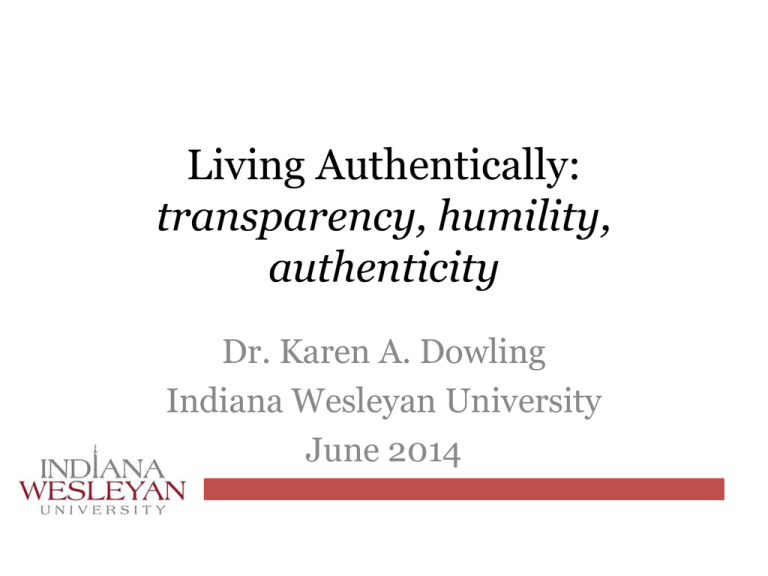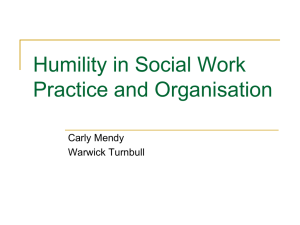Humility - The Summit
advertisement

Living Authentically: transparency, humility, authenticity Dr. Karen A. Dowling Indiana Wesleyan University June 2014 au·then·tic adjective \ə-ˈthen-tik : real or genuine : not copied or false : true and accurate : made to be or look just like an original Humility Can be viewed as low-regard, meekness, permissiveness – in essence a weakness -by those adhering to a “strong leader” paradigm Leadership for teacher leaders (ethics paradigm) Leadership characteristics (strong leader paradigm) Decisive Powerful Masculine Driven Self-assured Fearless Risk-taking Competitive The • • • • • for humility Remain humble Coach by questioning Truly care about team members as people Take the moral ground Become a consensus builder “Humility leads to strength and not to weakness: It is the highest form of selfrespect to admit mistakes and to make amends for them.” John J. McCloy If ethics is the study of values and customs of a particular person or group, then leadership ethics is the study of the values and customs of those who lead or seek to lead. Humility is a primary ethical consideration. “Humility is not thinking less of yourself, it’s thinking of yourself less” -C. S. Lewis 5 Ways To Teach Humility 1. Build Confidence: Often what passes for arrogance is actually fear. Some leaders attempt to “humble” other leaders or “put them in their place” through public criticism or embarrassment. This tactic actually has the opposite impact. We need teacher leaders who are confident enough to not need to talk about it. 5 Ways To Teach Humility 2. Teach the Art of Great Questions: Teach the art of provocative questions. Teach the power of pause. Ask your own questions “what does your team think about this idea?” “Who did you involve in this decision?” Questions that Intimidate and Disengage What do I have to do to get you to. Why did you do that? Did I ask you to do that? Is that really working? What is your experience in this area? Who gave you the authority to make that decision? Is that your final decision? Are you sure about that? What makes you think that will work? 3. Get Them Out of Their Comfort Zone: Give them a stretch assignment or project in an area they know nothing about. Nothing is more humbling than being clueless. Put them in arenas where they must rely on their team or peers to be successful. 4. Give them tools to manage their blind spots: Do a 360 assessment. Give them a coach. Encourage your team to surface and work through their own conflicts. 5. Model it • Be a servant leader • Admit when you are wrong • Coach privately • Recognize, honor and reward humble behaviors on teams, as ironic as this sounds. Minimize desire for folks to “toot their own horn” by tooting it for them. • Reject special treatment, even when it’s convenient. Live by the same rules and standards you expect your team to uphold. “Humility is how we express our delight– how we appreciate the simple pleasures and great joys. And equally, humility is how we open to life’s inconveniences and devastating tragedies. When we are humble, no experience is beneath us, no colleague is unworthy, no moment does not merit our full attention. Because we are humble, we do not pick and choose– savoring only the tasty parts of life and leaving the rest for others. We are wiling to experience the entire situation directly and work with every detail.” ~ Michael Carroll on the talent of humility Leading peers: pride, purpose, positive, persistence • • • • Pride, while understandably difficult to recognize, has presented the biggest hurdle. Get a bunch of highly motivated and charged individuals to attack a problem and you are bound to have people that think their way of doing things is the best and only way. Stay tied to the mission, vision and purpose. When you can stay focused on the core objective, it closes off some of the paths for ideas that do not apply to what is being accomplished. Foster positive conflict. Positive conflict is one of the greatest tools for overcoming a wide range of problems in a team. If everyone is on-board with this, the group as a whole will accept all ideas, but as a whole will choose the ones that will work best for the objective at hand. Accountability in a team means you do what you committed to doing. And everyone must hold everyone accountable for their commitments. If one is committed to doing something, then one should do everything they can to complete it or should give advance notice and ask for help. A leader needs to be confident enough to confront others that are not fulfilling their commitments. This might be better done publicly or privately depending on the circumstance. Also as the leader, you best be completing your assignments, if you want others to complete theirs. “What the world needs now is more geniuses with humility, there are so few of us left.” The first step is admitting that you’re struggling with pride. 9 Ways Confident Leaders Express Humility Understand they don’t have all the answers– and search for more Attract those who will tell the truth– and be able to hear them Reflect on their own leadership– and seek out change as needed Read about other approaches– and adjust Seek out mentors– from all levels Share more about themselves and create connections Seek to learn about the people they work with– and see them as people • Try out new behaviors and ask for feedback • Take stands against the politically correct choice • • • • • • • Transparent leaders are authentic and deliver their brand of honesty with respect and concern for others. There are no hidden agendas. Information is shared openly, yet appropriately. Transparency Check 1- weak 5-strong 1. Consistent in demonstrating who you truly are in work and home life. 2. Easily build connections, rapport, or relationships. 3. Able to keep confidentiality. 4. Can communicate bad news as easily as good news. 5. Know how to start conversations with others and get others to talk. 6. Can share opinions freely and keep emotions in check. 7. Have asked for others’ feedback on your performance. 8. Have engaged in self-reflection; self-motivated to examine own performance. 9. Are willing to admit to your mistakes. 10. Affirm others even when you disagree. Results? Be transparent by… • Being congruent between inner and outer self. No pretense. Pretending to be someone or something you are not will ultimately take its toll; both on you, those around you, and the bottom line of your organization. Make a conscious examination of your values, vision, mission and purpose, then align those elements with your daily life – both at work and at home. • Creating meaningful connections with team members. You can fake genuine consideration, but not for long. Don’t force an unnatural or uncomfortable bond with team members, but do go out of your way to get to know each person on a real level. What is important to them? How do their skills and values compliment your team? • Being sincere in word and deed. It is usually not appropriate to divulge all information without discernment. You don’t need to tell everyone everything, but never lie. Try phrases like, “I’m not at liberty to discuss that, but what I can tell you is…” People will respect both your candor and discretion with privileged information. • Communicating both good and bad news. Just like you, your team needs as many facts as they can muster to make intelligent decisions, opinions, and commitments. Don’t sugarcoat bad news to make it sound better, and don’t downplay or omit good news. Just tell the truth simply, and with a touch of compassion when necessary. • Revealing personal information within the context of work. Transparency is all about mindful revelation, so take advantage of opportunities to appropriately expose yourself once in a while. Meaningful connections are built on mutual respect and communication. So don’t just stockpile information about the people around you, share things about yourself to increase your own vulnerability and stake in the relationship. • Responsibly sharing true opinions and emotions. As stated above, never lie, but be responsible in the manner in which you share with others. For example, express your concern or disappointment, but without contempt. Explain your reasoning for a decision, but not at the cost of someone’s dignity. • Asking for feedback about their own performance. Don’t lie to your team, and take steps to ensure you aren’t lying to yourself. Ask those who you respect, and prepare yourself to accept their feedback with an open and gracious mind. While it takes courage to face criticism, appreciate the bravery it takes others (especially those whose jobs, positions, and wages depend on your view of them) to be frank with you. • Owning up to mistakes. It’s not just team members; everyone appreciates someone who can admit a mistake. The act of owning up to a wrong turn or bungled attempt demonstrates humility and a genuine desire to do the right thing. Bonus: the more your team members see you modeling this skill (although hopefully not TOO often), the more likely they will be to return the favor. Lencioni (2002) and Marcum & Smith (2007)— Humility is an appropriate selfawareness that avoids thinking too highly of ourselves, blended with a healthy self-respect that avoids thinking too little of ourselves—allowing us to realistically assess our own accomplishments while continuing the pursuit of our own personal development. Proper humility stems from the worldview and core values genesis of leadership Five key abilities: 1. Fallibility 2. Vulnerability 3. Transparency 4. Inadequacy, and 5. Interdependency The Leadership Onion: Foundational Themes Worldview and Values Talents and aptitudes Emotional Intelligence Personality preference Behaviors and Performance Focus on the core of the leadership onion—worldview and values. The fast pace of change, the multitude of daily responsibilities, the voice mails, grading, emails, meetings, and schedules of most teacher leaders leave little time for reflection on the deeper core beliefs, values, and worldview issues of life. Without time to reflect and develop a proper center, teacher leaders often accept, adopt, or borrow a worldview from others. Concepts such as Don’t get too close to the people you lead, or This isn’t personal, it’s business are dominant worldview statements that operate in the lives of many leaders today—often times with little or no reflective choice or intentionality. What is key? Examine your worldview. Who are you? Reflect. Socrates pointed out thousands of years ago, “The unexamined life is not worth living.” The root of humility—the Latin humus for ground or earth—hints at what appropriate self-awareness, feedback, and reflection does in the life of a leader, it keeps them grounded. Result Response Recognition Recognition |Response |Result Attribute : Fallibility Recognition: Response: Result: “I make mistakes.” “I need your patience.” Authenticity Recognition |Response |Result Attribute: Vulnerability Recognition: Response: Result: “I was wrong.” “I need your forgiveness.” Reconciliation Recognition |Response |Result Attribute: Transparency Recognition: Response: Result: “I don't know.” “I need your ideas.” Innovation Recognition |Response |Result Attribute: Inadequacy Recognition: Response: Result: “I can’t do it all.” “I need your talents.” Work/Life Balance Recognition |Response |Result Attribute: Interdependency Recognition: Response: Result: “I’m not here for me.” “I need your collaboration.” Talent Development Onion activity: TRANSPARENCY Fallibility—Accepting Imperfection and Seeking Authenticity • Having high-standards and holding oneself and others accountable for quality performance continues to be just as important. The difference is that by accepting and exposing personal fallibility, leaders cease to be above their followers and begin to create a safe environment for authenticity, where not only the leader but also everyone else can be authentic. Vulnerability—Asking Forgiveness and Seeking Reconciliation Vulnerability is a willingness to look at our own contribution to the crises, problems, and challenges we encounter. Consider the metaphor of a window and a mirror: when we have worked with leaders who struggle with vulnerability, their first reaction to a problem or crisis is to look out the window for someone to blame. Faced with the same problems or crises, leaders with true humility look first in the mirror to see how their own actions or inactions contributed to the problem. And when things are going well, these same humble leaders look out the window to acknowledge the contributions of others in their success. Transparency—Admitting Ignorance and Seeking Innovation • Recognizing that we don’t have to have all the answers and saying to our followers, “I don’t know” is a profoundly significant (and courageous) step. • For many, there is a deep-rooted fear associated with saying, I don’t know; they consider it as the ultimate sign of weakness in leadership. But the reality is that when followers see their leader make this acknowledgement, their natural response is to bring their best thinking to the leader. As leaders move from the recognition of their own ignorance to the response of telling their followers, I need your ideas, what often follows is the innovation and creative thinking required for the complex issues and challenges they face. When unleashed by an appropriately humble leader, this collaboration takes hold and energizes the followers. Using all team members’ gifts for innovation and success Inadequacy—Acknowledging Mortality and Seeking Work/Life Balance Humility requires leaders to courageously deal with their own inadequacy to work harder and longer—to keep more and more of today’s responsibilities while taking on more and more of tomorrow’s challenges. The statistics on burnout are staggering— work/life balance is an illusive, yet very important aspect of long-term leadership effectiveness. Interdependency—Moving from SelfCentered to Other-Centered and Developing Talent • One of the marks of great leaders, leaders who genuinely live out this humility, is the selflessness of their leadership. What they communicate is that it’s not about me. I’m not here for my own interests. • We’re All in this Together Tony Dungy: Humility and Leadership John Maxwell: 5 Levels of Leadership Note what is included in the highest level! Questions and Listening as Essential Tools of Humility in Leadership Two very practical fruits of true humility are the ability to ask great questions and the ability to listen well. Active listening • “What I think I hear you saying is…” • “In other words, you think that…” • “Correct me if I’m wrong, but aren’t you saying…” • “Let me review what I’ve heard you say. Please correct me if I leave anything out.” • “I hear you saying…Is that right?” Active Listening: Yes or No? 1. 2. 3. 4. 5. 6. 7. 8. 9. I allow the other person to finish what s/he is saying before I speak. I pay attention even when I don’t like the speaker. I easily ignore distractions when I am listening. I can easily remember what people say to me. I ask the speaker questions when I don’t understand something. I look at people when they are talking to me. I don’t do other things when I am listening. I keep listening even when the message is too complicated. I ignore behavior or appearances that bother me and listen to what the speaker is saying. 10. I wait to chime in with my “advice” after listening to someone. Results? 1. Seek to understand before seeking to be understood. When we seek to understand rather than be understood, our modus operandi will be to listen. Often, when we enter into conversation, our goal is to be better understood. We can be better understood, if first we better understand. With age, maturity, and experience comes silence. It is most often a wise person who says little or nothing at the beginning of a conversation or listening experience. We need to remember to collect information before we disseminate it. We need to know it before we say it. 2. Be non judgmental. Empathetic listening demonstrates a high degree of emotional intelligence. If we would speak to anyone about issues important to them, we need to avoid sharing our judgment until we have learned their judgment. 3. Give your undivided attention to the speaker. Absolutely important is dedicating your undivided attention to the speaker if you are to succeed as an active listener. 4. Use silence effectively. The final rule for active or empathic listening is to effectively use silence. – “The word listen contains the same letters as the word silent.” – Alfred Brendel – “The most important thing in communication is to hear what isn’t being said.” – Peter Drucker – “Most people do not listen with the intent to understand. They listen with the intent to reply. – Stephen R. Covey It's Not About The Nail Covey’s 7 Habits of Effective Leaders Habit 5: Seek First to Understand, Then to be Understood • Use empathic listening to be genuinely influenced by a person, which compels them to reciprocate the listening and take an open mind to being influenced by you. This creates an atmosphere of caring, and positive problem solving. Habits of mind Listening to Others with Understanding and Empathy • Identify the most common "listening setasides" in conversation so that students can begin to recognize common "errors" that occur in everyday communication. These errors might include comparing, judging, placating or giving advice instead of really listening and understanding a message. Empathetic Listening • • • • • • Eyes Mouth Neck Hands Feet Back z Kotter’s 5 Mental Habits Successful Leaders Need 1. 2. 3. 4. 5. Risk taking Humble self-reflection Solicitation of opinions Careful listening Openness to new ideas Humility=head, heart, hands, human • Effective leaders ask the who question before the what • Look out the window when things go right and in the mirror when things go wrong • The Power of a Team How to encourage humility: invite feedback encourage dissent turn failures into opportunities expect humility in others Exhibiting humility in my leadership: how do I show humility? how can I show humility? Self SWOT on Leadership Habits STRENGTHS RISK TAKING SELFREFLECTION TEAM CONCEPT/ RELATIONSHIPS LISTENING OPENNESS TO NEW IDEAS WEAKNESSES OPPORTUNITIES THREATS







